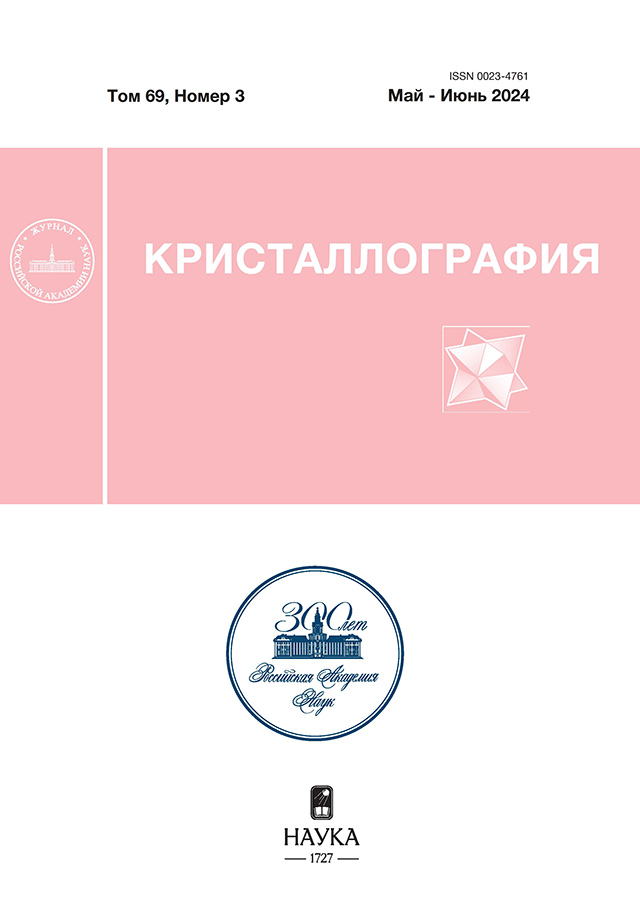Effect of a traveling magnetic field on the parameters of doped tellurium gallium arsenide single crystals grown by the chokhralsky method
- Autores: Yugova T.G.1, Chuprakov V.A.1, Sanzharovsky N.A.1, Yugov A.A.1, Martynov I.D.1, Knyazev S.N.1
-
Afiliações:
- The State Research and Design Institute of the Rare Metal Industry (JSC Giredmet)
- Edição: Volume 69, Nº 3 (2024)
- Páginas: 393-399
- Seção: REAL STRUCTURE OF CRYSTALS
- URL: https://rjmseer.com/0023-4761/article/view/673168
- DOI: https://doi.org/10.31857/S0023476124030036
- EDN: https://elibrary.ru/XPGUJR
- ID: 673168
Citar
Texto integral
Resumo
The effect of a traveling magnetic field on the parameters of Te-doped GaAs single crystals in the carrier density range of 5 × 1017–2 × 1018 cm–3 has been studied. A traveling magnetic field was induced in a melt by a graphite inductor located in the setup chamber around the main heater. It is shown that a high-frequency magnetic field slightly reduces the dislocation density in the crystals without changing the shape of the dislocation distribution over their cross sections. The magnetic field affects the impurity distribution along the crystal axis, almost doubling the distance between the striation bands from 9 µm in the absence of magnetic field to 17 µm in a field with a frequency of 300 Hz.
Texto integral
Sobre autores
T. Yugova
The State Research and Design Institute of the Rare Metal Industry (JSC Giredmet)
Autor responsável pela correspondência
Email: P_Yugov@mail.ru
Rússia, 111524 Moscow
V. Chuprakov
The State Research and Design Institute of the Rare Metal Industry (JSC Giredmet)
Email: P_Yugov@mail.ru
Rússia, 111524 Moscow
N. Sanzharovsky
The State Research and Design Institute of the Rare Metal Industry (JSC Giredmet)
Email: P_Yugov@mail.ru
Rússia, 111524 Moscow
A. Yugov
The State Research and Design Institute of the Rare Metal Industry (JSC Giredmet)
Email: P_Yugov@mail.ru
Rússia, 111524 Moscow
I. Martynov
The State Research and Design Institute of the Rare Metal Industry (JSC Giredmet)
Email: P_Yugov@mail.ru
Rússia, 111524 Moscow
S. Knyazev
The State Research and Design Institute of the Rare Metal Industry (JSC Giredmet)
Email: P_Yugov@mail.ru
Rússia, 111524 Moscow
Bibliografia
- Terashima K., Fukuda T. // J. Cryst. Growth. 1983. V. 63. P. 423. https://doi.org/10.1016/0022-0248(83)90236-1
- Osaka J., Kohda Н., Kobayashi Т., Hoshikawa К. // Jpn. J. Appl. Phys. 1984. V. 23. P. L195. https://doi.org/10.1143/JJAP.23.L195
- Terashima K., Katsumata T., Orito F. // Jpn. J. Appl. Phys. 1984. V. 23. P. L302. https://doi.org/10.1143/JJAP.23.L302
- Hoshi K., Isawa N., Suzuki T., Ohkubo Y. // J. Electrochem. Soc. 1985. V. 132. P. 693. https://doi.org/10.1149/1.2113933
- Terashima K., Fukuda T. // J. Cryst. Growth. 1983. V. 63. P. 425. https://doi.org/10.1016/0022-0248(83)90236-1
- Shiraishi Y., Takano K., Matsubara J. et al. // J. Cryst. Growth. 2001. V. 229. P. 17. https://doi.org/10.1016/S0022-0248(01)01042-9
- Sleptsova I.V., Senchenkov A.S., Egorov A.V. et al. // Proceedings of Joint 10th European and 6th Russian Symposium on Physical Sciences in Microgravity. St. Petersburg. Russia. 15–21 June 1997. 2. P. 68.
- Ataka M., Katoh E., Wakayama N.I. // J. Cryst. Growth. 1997. V. 173. P. 592. https://doi.org/10.1016/S0022-0248(96)00821-4
- Yesilyurt S., Motakef S., Grugel R., Mazuruk K. // J. Cryst. Growth. 2004. V. 263. P. 80. https://doi.org/10.1016/J.JCRYSGRO.2003.11.066
- Lyubimova T.P., Croёll A., Dold P. et al. // J. Cryst. Growth. 2004. V. 266. P. 404. https://doi.org/10.1016/j.jcrysgro.2004.02.071
- Rudolph P. // J. Cryst. Growth. 2008. V. 310. P. 1298. https://doi.org/10.1016/j.jcrysgro.2007.11.036
- Gräbner O., Mühe A., Müller G. et al. // Mater. Sci. Eng. B. 2000. V. 73. P. 130. https://doi.org/10.1016/S0921-5107(99)00452-3
- Vizman D., Gräbner O., Müller G. // J. Cryst. Growth. 2001. V. 233. P. 687. https://doi.org/10.1016/S0022-0248(01)01633-5
- Hurle D.T.J., Series R.W. // Handbook of Crystal Growth / Ed. Hurle D.T.J. North-Holland: Elsevier, 1994. V. 2a. P. 259. https://doi.org/10.1107/S010876739709990X
- Kimura T., Katsumata T., Nakajima M. et al. // J. Cryst. Growth. 1986. V. 79. P. 264. https://doi.org/10.1016/0022-0248(86)90447-1
- Ozawa S., Nakayama H., Shiina Y. et al. // Inst. Phys. Conf. Ser. 1989. V. 96. P. 343.
- Rudolph P., Czupalla M., Lux B. // J. Cryst. Growth. 2009. V. 311. Р. 4543. https://www.researchgate.net/publication/282977027_Crystal_growth_from_melt_in_combined_heater-magnet_modules
- Abrachams M.S., Buiocchi C.J. // J. Appl. Phys. 1965. V. 36. P. 2855. https://doi.org/10.1063/1.1714594
- Мильвидский М.Г., Освенский В.Б. Структурные дефекты в монокристаллах полупроводников. М.: Металлург, 1984. С. 75. https://www.studmed.ru/milvidskiy-m-g-osvenskiy-v-b-strukturnye-defekty-v-monokristallah-poluprovodnikov_6a780cf3b60.html
- Ugova T.G., Belov A.G., Knyazev S.N. // Crystallography Reports. 2020. V. 65. P. 7. https://doi.org/10.1134/S1063774520010277
- Патент DE10 2007 020 39 134 от 03.09.2009.
- Мильвидский М.Г., Освенский В.Б. Структурные дефекты в монокристаллах полупроводников. М.: Металлург, 1984. С. 93. https://www.studmed.ru/milvidskiy-m-g-osvenskiy-v-b-strukturnye-defekty-v-monokristallah-poluprovodnikov_6a780cf3b60.html
- Мильвидский М.Г., Освенский В.Б. Структурные дефекты в монокристаллах полупроводников. М.: Металлург, 1984. С. 172. https://www.studmed.ru/milvidskiy-m-g-osvenskiy-v-b-strukturnye-defekty-v-monokristallah-poluprovodnikov_6a780cf3b60.html
- Scheel H.J. // J. Cryst. Growth. 2006. V. 287. Р. 214. https://doi.org/10.1016/j.jcrysgro.2005.10.100
Arquivos suplementares
















